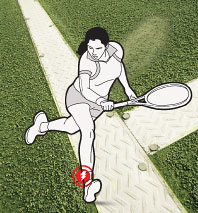Concrete is rough on joints. No surprise, but unfortunate nonetheless, since it’s the most common surface on public courts. Plan for pain management beforehand. Orthopedic surgeon Jerry Lubliner breaks down the city’s most popular surfaces—hard, Har-Tru, and red clay—by how punishing they are on various body parts.

HARD
Concrete or asphalt courts are the easiest to maintain, hence the most common in the city. They’re also the toughest on the body. “When you step on a hard court, all the stress is transmitted through the legs into the spine, starting in the ankle. On a hard surface, you get overuse injuries that can lead to tendonitis in the ankles and knees. As you get older, arthritis can be aggravated by hard courts.” AGONY-METER … … .


HAR-TRU
The claylike surface, made of crushed stones, is faster and more predictable than real clay. “You can get to a ball and slide into it, so there’s less impact. When your foot hits the ground, the body absorbs the reactive force,” making it less stressful on ankles, knees, and spine. “A court that has a little bit of slide will lessen injuries because your foot doesn’t get stuck to the surface.” AGONY-METER … … .


RED CLAY
If clay courts get too humid and sticky, they can cause Achilles’ and muscle injuries because feet can’t slide as well when changing directions. But under normal conditions, the surface is a good shock absorber for joints, just like Har-Tru. “There’s very little difference between clay and Har-Tru,” says Lubliner. “When you run and dig in a little on Har-Tru or clay, the floor is taking part of the force.” AGONY-METER … … .
